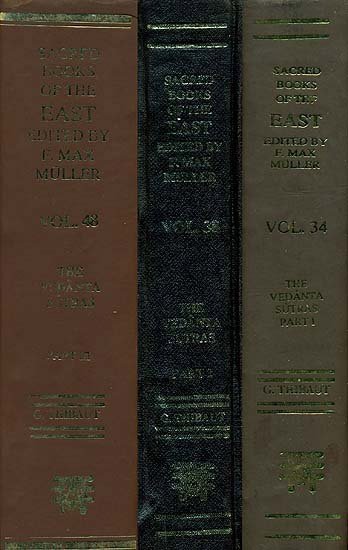Brahma Sutras (Ramanuja)
by George Thibaut | 1904 | 275,953 words | ISBN-10: 8120801350 | ISBN-13: 9788120801356
The English translation of the Brahma Sutras (also, Vedanta Sutras) with commentary by Ramanuja (known as the Sri Bhasya). The Brahmasutra expounds the essential philosophy of the Upanishads which, primarily revolving around the knowledge of Brahman and Atman, represents the foundation of Vedanta. Ramanjua’s interpretation of these sutras from a V...
Sutra 3.3.6
6. If it be said that there is difference on account of the text; we say no; on account of non-difference.
So far it has been shown that the non-difference of injunction, and so on, establishes the unity of meditations, and that owing to the latter the special features of meditation enjoined in different texts have to be combined. Next, an enquiry is entered upon whether in the case of certain particular meditations there actually exists, or not, that non-difference of injunction which is the cause of meditations being recognised as identical. A meditation on the Udgītha is enjoined in the text of the Chandogas, as well as in that of the Vājasaneyins (Ch. Up. I, 2; Bṛ. Up. I, 3); and the question arises whether the two are to be viewed as one meditation or not. The Pūrvapakshin maintains the former alternative. For, he says, there is no difference of injunction, and so on, since both texts enjoin as the object of meditation the Udgītha viewed under the form of Prāṇa; since there is the same reward promised in both places, viz. mastering of one’s enemies; since the form of meditation is the same, the Udgītha being in both cases viewed under the form of Prāṇa; since the injunction is the same, being conveyed in both cases by the same verbal root (vid, to know); and since both meditations have the same technical name, viz. udgītha-vidyā. The Sūtra states this view in the form of the refutation of an objection raised by the advocate of the final view. We do not admit, the objector says, the unity maintained by you, since the texts clearly show a difference of form. The text of the Vājasaneyins represents as the object of meditation that which is the agent in the act of singing out the Udgītha; while the text of the Chandogas enjoins meditation on what is the object of the action of singing out (i. e. the Udgītha itself). This discrepancy establishes difference in the character of the meditation, and as this implies difference of the object enjoined, the mere non-difference of injunction, and so on, is of no force, and hence the two meditations are separate ones.—This objection the Pūrvapakshin impugns, 'on account of non-difference.' For both texts, at the outset, declare that the Udgītha is the means to bring about the conquest of enemies (Let us overcome the Asuras at the sacrifices by means of the Udgītha' (Bṛ. Up.); 'The gods took the Udgītha, thinking they would with that overcome the Asuras'—Ch. Up.). In order therefore not to stultify this common beginning, we must assume that in the clause 'For them that breath sang out' (Bṛ. Up.), the Udgītha, which really is the object of the action of singing, is spoken of as the agent. Otherwise the term udgītha in the introductory passage ('by means of the Udgītha') would have to be taken as by implication denoting the agent (while directly it indicates the instrument).—Hence there is oneness of the two vidyās.—Of this view the next Sūtra disposes.
